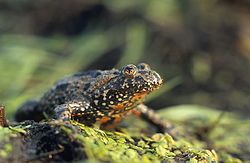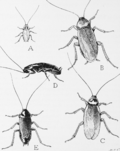Kin recognition, also called kin detection, is an organism's ability to distinguish between close genetic kin and non-kin. In evolutionary biology and...
29 KB (3,804 words) - 08:16, 5 April 2025
cost to the actor. Hamilton proposed two mechanisms for kin selection. First, kin recognition allows individuals to be able to identify their relatives...
63 KB (7,643 words) - 16:42, 20 January 2025
Carpenter ant (section Kin recognition)
prevent incest and promote kin selection. Social carpenter ants recognize their kin in many ways. These methods of recognition are largely chemical in nature...
40 KB (4,271 words) - 17:09, 15 May 2025
Inbreeding avoidance (section Kin recognition)
used as a meter for kin recognition. Individuals can also use their own characteristics or phenotype as a template in kin recognition. For example, in one...
32 KB (3,781 words) - 00:08, 26 February 2025
Ratnieks, Francis L. W.; Gyllenstrand, Niclas; Thorén, Peter A. (2001). "Colony kin structure and male production in Dolichovespula wasps" (PDF). Molecular Ecology...
19 KB (2,346 words) - 21:33, 19 February 2025
Inclusive fitness in humans (redirect from Human kin selection)
for kin to aggregate and for individuals to behave preferentially towards nearby kin, whether or not this behaviour is the result of kin recognition per...
31 KB (4,337 words) - 21:11, 27 February 2025
serve in identifying the individual's species, and more importantly, kin. Kin recognition occurs because each species has a unique cuticular hydrocarbon composition...
27 KB (3,312 words) - 16:45, 29 April 2025
mating with close kin. Advertisement vocalizations given by males appear to serve as cues by which females recognize kin. Kin recognition thus allows avoidance...
6 KB (549 words) - 12:04, 20 March 2025
involving common shelter, social dependence, information transfer and kin recognition. Cockroaches have appeared in human culture since classical antiquity...
80 KB (8,383 words) - 22:08, 13 May 2025
Plant root exudates (section Kin recognition)
the roots to inhibit harmful microbes and promote the growth of self and kin plants. Plant root systems can grow to be complex due to a variety of species...
19 KB (2,606 words) - 17:26, 24 November 2024
Behavioral ecology (section Kin recognition)
stingless bee species Trigona fulviventris can distinguish kin from non-kin through recognition of a number of compounds, including hydrocarbons and fatty...
110 KB (14,230 words) - 09:03, 18 April 2025
Formica truncorum (section Cuticular kin recognition)
specialized tasks. Eusocial behaviour is thought to have evolved as a result of kin selection within monogamous colonies. In multiply mated colonies, the relatedness...
18 KB (2,328 words) - 01:46, 2 May 2025
females with which they mated. P. carolina demonstrates altruistic behavior in kin feeding. Many Polistes females feed their own progeny preferentially to increase...
19 KB (2,188 words) - 21:57, 31 March 2025
does play a role in kin recognition, the genetic differences in odor are thought to be more critical in kin recognition. Kin recognition is beneficial for...
21 KB (2,685 words) - 01:43, 5 October 2023
ensures that the queen's sons predominate. Experiments confirming the role of kin selection in worker policing demonstrate the effects of multiple matings...
26 KB (3,088 words) - 07:42, 15 January 2025
Vespula pensylvanica (section Kin recognition)
assumes the role of queen in a nest that is not hers. This may mean that kin recognition is not occurring in these circumstances. Though this is not common...
27 KB (3,692 words) - 15:09, 22 December 2024
inbreeding occurs. This relatedness was measured among 216 queens. No kin recognition is seen in P. occidentalis. The wasps can differentiate between those...
24 KB (3,124 words) - 23:54, 22 October 2024
23%. Additionally, the lipids in the nest paper probably function in kin recognition among workers. The matter of sex ratio is related. Within the genus...
42 KB (5,318 words) - 17:01, 14 May 2025
the two groups include various social behaviours, trail following, kin recognition, and methods of communication. Cladistic analysis of five DNA sequences...
27 KB (2,882 words) - 14:39, 28 February 2025
inadvertently eliminate some of its own genes from the available gene pool. Kin recognition has been observed in tadpoles of the spadefoot toad, whereby cannibalistic...
42 KB (5,095 words) - 17:55, 14 May 2025
Bombus vosnesenskii (section Kin recognition)
indicates some sort of species-specific chemical cue that initiates recognition and incubation of a brood clump, as opposed to individual body odor or...
20 KB (2,517 words) - 01:49, 2 May 2025
polymorphic scent signal of genetic identity that appears to underlie kin recognition and inbreeding avoidance. Thus, there are fewer matings between mice...
62 KB (7,527 words) - 21:28, 11 May 2025
appear to be able to discriminate the odour of their kin from the odour of their non-kin. Kin recognition is a useful ability that facilitates both cooperation...
129 KB (14,163 words) - 06:46, 12 April 2025
show nepotism (preferential behavior toward their kin) and also avoid inbreeding. This kin recognition is by olfactory cues from urine, feces and glandular...
141 KB (14,613 words) - 04:37, 8 May 2025
one of the two species of bumblebee observed to use pheromones in kin recognition. The other is the frigid bumblebee, Bombus frigidus. Bombus vancouverensis...
16 KB (1,900 words) - 18:11, 22 April 2025
from the nest. Research on second-generation bees illustrates that kin recognition of nest mates is not a genetically based behavior. Further, fratricide...
30 KB (3,626 words) - 15:45, 22 August 2024
been used as a model of study to figure out mechanisms of kin recognition. Kin recognition can be coded by observing various treatments of certain wasps...
31 KB (4,026 words) - 12:30, 14 February 2025
Evolutionary psychology (section Family and kin)
toward their kin than toward non-kin, the relevant proximate mechanisms that mediate this cooperation have been debated (see kin recognition), with some...
162 KB (18,799 words) - 21:17, 28 April 2025
direct "kin recognition". The relative place of these two broad types of social mechanisms has been debated (see Kin selection and Kin recognition), but...
47 KB (5,883 words) - 22:59, 12 May 2025
























